Vickers Viscount Network
September 2008 Newsletter
Dear Member
WELCOME to the September edition of the Vickers Viscount Network newsletter. Interest in the
Viscount through the website and newsletter continues to gain momentum. As soon as a newsletter gets issued the
readers start looking up their resources to provide an answer and that is exactly what we (including you) want.
Seems like some members have room(s) full of thousands of slides (not necessarily Viscounts) waiting to be
scanned for prosperity. Thank goodness there were only 444 Viscounts built! The point is, folk out there
visiting our site can now see that other folk want to see their photographs. A much better idea than having
much loved collections consigned to the incinerator supposedly unwanted.
CAPITAL AIRLINES BUTTONS
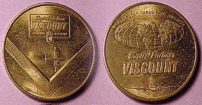
Capital Airlines Viscount token.
Christa Walker contacted us about an old token that she has run across and has asked for some information on it
like its age and why it was issued. It is bronze/brass in colour, a little bigger than a quarter, has a Capital
Airlines Viscount logo on one side and a globe type picture on the other. It carries the legend 'Worlds 1st
Turbo Prop Airliner'.
Vickers Viscount Network USA researcher Andrew Fraize sent in the above photo and believes that Capital Airlines issued them in the mid 1950s to promote their new Viscount aircraft. Can someone enlighten readers of the reason for the buttons?
VISCOUNT ZS-CDT / ZS-SBT c/n 346
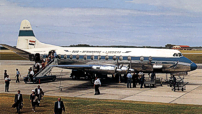
SAA Viscount ZS-CDT was due to
be re-registered ZS-SBT.
This aircraft's history sheet queries as to when the new registration ZS-SBT (not taken up) was allocated.
Tony Ward advises that at the end of 1968 SAA - South African Airways changed its registration
policy and was allocated blocks in the ZS-S** range. SAA aircraft then in service or on order had their
original registrations changed, and this change-over took place from January 1969. However we still do not
know why the SAA Viscount fleet were issued new registrations that were then not taken up?
DART ENGINES DISPLAYED IN DERBYSHIRE
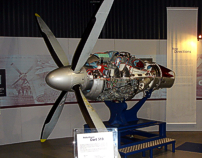
The Rolls-Royce Dart Mk.510.
Vickers Viscount Network UK researcher George Stringer visited the Rolls-Royce Heritage Trust
Exhibition and says:-
My visit to the exhibition was very interesting. On entering, the first exhibits were Rolls-Royce cars; there
were two which were very early but in wonderful condition. The aircraft engines came next, they included Hawk,
Eagle, Kestrel, Griffin, Merlin and Dart engines, plus all the jet engines they produced to the current time.
The details of them all are shown on display boards and pictures around each exhibit.
My main interest was the Dart Mk.510 that had cut away parts showing the inside details of the engine. The
collection and presentation is well worth a visit.
The Rolls-Royce Heritage Trust Exhibition is open by appointment only and can be found at:-
Rolls-Royce Heritage Centre, Derby Branch, P.O. Box 31, Derby, England DE24 8BJ
http://www.bbc.co.uk/derby/in_pictures/360_panoramas/rolls_royce_heritage_centre/
Vickers Viscount Network UK researcher Jamie Popplewell
jamie.popplewell@vickersviscount.net
consequently asked if Rolls-Royce Darts ever come up for sale as he wants one for a winter project. Well, do
they . . .?
HELP REQUIRED
Are you a problem solver? Would you like to test your skills at research? Then look no further than our
'Mystery' page and help us identify these Viscounts by selecting on our site [Listings] and [Help us
Identify these Viscounts]. From time to time we receive photos of aircraft that we cannot identify. These
important images often point to a missing part of Viscount histories and need to be solved.
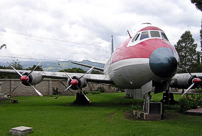
Help us identify this Viscount with false registration HC-CAG.
VISCOUNT AT PUEMBO, ECUADOR
Vickers Viscount Network UK researcher Ed Jones has asked if we can identify this Viscount? The four
photos on our site were taken by Stefano Rota on the 1st May 2004 at Puembo, Ecuador. Stefano says that
the aircraft is complete, is stored in a private garden, used to belong to a rich man in the Air Force, and
carries the false registration HC-CAG that may be derived from the owners initails'.
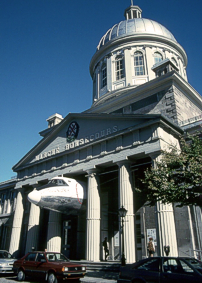
Is this Viscount c/n 385 or c/n 308?
VISCOUNT AT BONSCOURSE MARKET, MONTREAL, CANADA
Debate surrounds this aircraft's identity. Firstly Vickers Viscount Network UK researcher Simon Ellwood
suggested that it might be CF-TIE c/n 385, then Roy Blewitt suggested that it might be CF-THZ / C-FTHZ
c/n 308. Can someone conclusively identify this aircraft please?
Once you have marvelled over the photos and aircraft, put on your thinking caps and see if you can help us
solve these mysteries.
VISCOUNT ZK-BRF UPDATE ON PROGESS
AND PART NUMBER SYSTEM
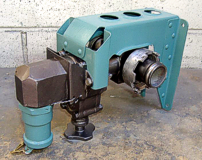
A restored power drain valve
in its mounting bracket.
The restoration of ZK-BRF in New Zealand is proceeding at a great pace. Perhaps what is particularly impressive
is the amount of work Vickers Viscount Network member Denys Jones and his team are putting into the
areas inside the aircraft and out of view. It just shows the passion they have to make the aircraft as complete
as possible. It seems logical that if you have a pile of parts which came out of the aircraft then they should
go back in, wherever they belong. Have a look on our site at [News] [Viscount Restoration News] [ZK-BRF c/n
283] and [September 2008].
Denys naturally seeks clarification from those in the know on the numbering system of Viscount parts and would
be most appreciative to receive advice - all for a good cause. He writes:-
Here's a query for the erudite out there.
As the runs go the length of the fuselage the prefix numbers of the parts change - 70182 then 72482, then 80282.
So how are those assigned and why the splits? The suffix numbers are mostly odd numbers, why? Did they expect
to add in parts later? Also frequently the items have no number but are called out with a 'Sht' number. Why do
this? All parts would have a 'Sht' for their detailed drawing so why single out some this way? Equally why don't
the numbers run in order? For example in one place the parts run as -63, -65, Sht105, -27, -213, -215. (Note;
'Sht' is an abbreviation for 'Sheet'.)
I'm curious as to this and would appreciate any insights. Please contact me at
denys.jones@vickersviscount.net
MEMBERS' CORNER - SHARE YOUR EXPERIENCE
Alain Van Severen recalls his days of flying Viscounts in circumstances far removed from those to which
most readers are accustomed. He apologises for mistakes "as English is not my first language". No problem. We
understood his story and grammar checked it. Enjoy!
"In September 1996 I was flying Boeing B-727s for Shabair Airlines, the major airline of Zaire but due to the
company's financial difficulties it was getting difficult to be paid regularly. About then the Bazair boss
offered me a job flying his Viscount based in Kisangani (FZKI) on passenger and cargo trips to and from Isiro
(FZJH), Bunia (FZKA) a runway full of holes, Beni (FZ??) an unpaved dirt airstrip 1,200m long, plus a few other
places.
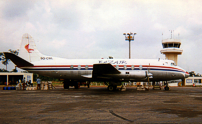
Bazair Viscount c/n 280 9Q-CWL.
I was offered good money to fly Viscount c/n 280 9Q-CWL, that I first flew on 24 September 1996. I soon realized
it wasn't in good shape. The water methanol system had been removed to gain weight and to save money, the
anti-skid system was deactivated, most of the flight instruments weren't functioning properly and I had to rely
on a single Garmin GPS for navigation. VORs and ADFs were usually inop., radar was obsolete, the hydraulic and
electrics weren't reliable; not to mention the completely useless fuel trimmers! I hadn't flown a turboprop
before. I had about 2,000 hours on pistons and 3,500 hours on jets, but I knew nothing about Rolls-Royce Dart
engines.
My new boss hired a Belgian instructor from Kinshasa to train me. Training consisted of a few sectors to
explain the specifics of the Viscount, the engines and propellers (no manuals available) and also to determine
how much overload we could safely carry out of the different runways. To achieve this we would start by loading
the aircraft to the max take off weight and then increase this by a few hundreds kilograms on each following
flight until we decided it was enough. Of course the boss always wanted more. He was taking-off much heavier
than me, but it was his aeroplane. I set up my own limits which he accepted.
With the anti-skid system u/s I blew a few tyres landing on bad and short runways, mainly in Bunia, before I got
used to gently moderating the braking pressure by watching the brake pressure gauge. After 12 sectors I was
checked-out, licence endorsed with a type rating V.781, and the fun began.
My co-pilot, a nice Zairian, was not capable of flying properly. I used him as autopilot to keep the aircraft
straight and level in cruise. At top of the descent I took control to avoid stupid mistakes. If for any reason
he had to land by himself I don't think we would have made it!
Then the boss wanted me to take-off from different places at twilight to fly back to Kisangani and land at
night, then to fly more sectors the next day. Kisangani was the only lighted runway for hundred of miles, in
the middle of the forest and with unreliable power supply. I refused.
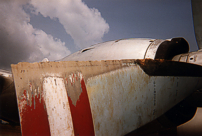
A badly worn propeller on 9Q-CWL.
Almost daily an engine would refuse to start. The other engines had to be shut down and an engineer summoned.
First they checked the ignition by listening to the spark noise in close proximity of the engine. If okay,
they would take a hammer or a heavy tool and bang on the fuel pump and FCU and try another start. Sometimes it
worked. If it didn't, they would pull a box of spare parts out the hangar, remove and dismantle the HP fuel
pump then reassemble it using different old parts found in the box. If doing this to the HP fuel pump wouldn't
fix the problem they would do the same with the FCU, or other engine accessories. Sometimes it took a couple of
days to get the engine to start. Of course these components were not supposed to be repaired by an untrained
mechanic in the middle of nowhere. But hey, this was Africa!
Once on take-off we lost about 50% of the torque on one engine. I managed to climb at 100-200 fpm, make a
gentle turn and returned to land. Luckily I never completely lost an engine on take-off with this aircraft. But
I had other problems such as electrical failures, hydraulic leaks, etc. I got in the routine of this operation
after a while.
1996 was also the year when the civil war in Zaire was spreading around the country and rebel troops led by
Lauren Kabila (who became president in 1997), supported by Rwanda and Uganda, were fighting in eastern Congo.
At the time when I started with Bazair they had already invaded the City of Bukavu and were marching northwards
to Goma, then Beni, Bunia, and Kisangani, eventually gaining control of the whole country in mid 1997. In
December the army requisitioned the aircraft and forced me to fly troops, ammunitions and supply to the front
to fight the rebels of Mr Kabila. The aircraft was loaded at night with ammunition.
Troops in full combat gear boarded daily and we flew them to Beni, an uncontrolled airport with a 1,200m dirt
airstrip. We used to operate there in daylight but because we didn't know if during the night the city had
been invaded or not. I had to make a very low pass over the airfield to check if the people on the ground were
the good or the bad guys. If they were the bad guys, by flying very low, I was hoping they wouldn't have time
to shoot as us. Then circle, land and unload quickly.
Now we faced an unreal situation: you have to realise that the regular army was not fighting the rebels, but
were fleeing the combats with their families and belongings, and looting everything they could when passing
each village. There were hundreds of people on the airfield with piles of baggage ranging from mattress,
furniture, all kind of electrical equipment, bicycles, motorcycles to animals such as chickens, dogs, goats,
sheep, etc. Of course they all wanted to fly to Kisangani with us to get away from the rebels as we were the
only aircraft still landing there.
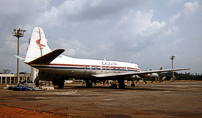
I used to open the rear door
only to load luggage and people.
I used to open the rear door only to load luggage and people. The load master and I were standing on each side
of the ladder to evaluate the weight of each item coming on board. Then we did the same with the passengers.
Same technique to evaluate the weight: the big woman: 85Kg, the baby: 10Kgs, the little girl: 25Kgs, etc. I put
a low weight limit as this technique was approximate at best. But of course when saying it was enough, there
was a big protest in the crowd facing me and a few soldiers would come to me, arming their Kalashnikovâs,
saying something like you took 7 families of Green Beret, you have to take 7 families of Red Berets as well, or
whatever army section they belong to. Clearly, it was 100% chaos!
The situation got so out of control after a few days that I had no idea of what weight I had on board. For
take-off I let the aircraft accelerate until the last few meters of the airstrip before rotating. On the last
flight we almost hit trees on the extended centreline and I decided it was enough. I spoke to the co-pilot and
the load master and told them I would not continue like this, that I was going to shutdown an engine in cruise,
land on 3 engines and explain to the army General in Kisangani that the engine was damaged and we had no spares
to fix it. They all agreed to this. This was my last flight on 9Q-CWL. The next day I boarded an aircraft to
Kinshasa on my way to a few other African adventures.
Sadly this aircraft crashed about 6 month later, in mid 1997. It took off from Bunia with the boss owner at the
controls. There were about 40 people on board and a few drums of Jet A1. Somehow there was an in flight cabin
fire. They declared an emergency saying they were going to attempt a crash landing on a small bush strip.
Apparently the aircraft exploded on short final, killing all occupants.
If all this sounds crazy (some pilots enjoy making up stories), you must realise that some people were doing
much crazier things, taking off with much heavier loads, especially Russian crews on Russian aircraft, flying
aircraft in far worse conditions, but it was quite normal in a country where corruption allowed anything; where
the rule was "no rules". The situation has worsened considerably. There are numerous crashes in Congo every
year; all due to poor maintenance, overloads, lack of training, etc. But we never get to hear about them.
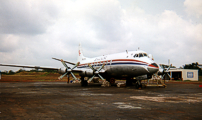
It was a strong aircraft with indestructible engines.
I cannot say I enjoyed flying the Viscount but this is due to circumstances. It was a strong aircraft with
indestructible engines. There was no proper maintenance on this particular aircraft but it kept flying, and it
did well everyday (when we could start all engines) with big overloads from very badly maintained runways, in
adverse weather over unforgiving terrain. My own experience on the Viscount lasted just three months but this
aircraft had been doing the same for years, as did all other Viscounts in Zaire. It is a testimony of how
strong and reliable these aircraft were.
I'm glad I did it but wouldn't do it again. I believe there are still one or two Viscounts flying in
Democratic Republic of the Congo now.
Alain Van Severen
And from Dave Peters in Canada . . . bit tamer there, but still exciting stuff!
Early in my career with Air Canada I remember a story told by a senior Captain about his days on the Viscount.
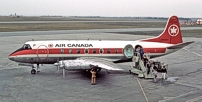
Air Canada Viscount
c/n 223 CF-THF.
It was a night take off from London, Ontario, shortly after the gear was retracted, a fast moving object was
seen approaching the aircraft followed by a very loud thump. I don't know how many of you have had a bird
strike but it is a very impressive event.
The Captain was flying the aircraft at the time and became more alarmed when he heard the First Officer
announce that he had been hit. In the dim cockpit lighting he could see that his First Officer was covered in
blood. The Captain continued the initial climb, safely configured the aircraft, engaged the autopilot and then
turned on the cockpit floodlighting to aid the First Officer. As he looked at his partner he asked, "Are you in
any pain?" The First Officer replied "No" as he felt with his hands to find the source of the blood flow. The
Captain then asked "When exactly did you grow feathers?" No reply. "Then I can assume the bird wing caught in
the sliding window is not yours."
As you may know the sliding cockpit windows do not provide a perfect seal in an unpressurised state. The bird
strike occurred as the aircraft was pressurising. The impact of the Seagull opened the window enough that the
remains entered the cockpit, splattered the First Officer, then it sealed normally.
Other than an in-flight Cockpit cleaning and wardrobe change the flight continued to destination normally.
LATEST UPDATES
In the August 2008 newsletter we included a story from Ali Berry regarding her father's involvement with
Viscounts in the 1950s. Subsequently she has supplied a copy of his newspaper report from 26 January 1958
concerning 24 Viscounts belonging to BEA, Air France and Aer Lingus being grounded because of cracks in the
main spar. At this time 260 Viscounts had been built but it was only this first batch that had the problem.
The fault was found by an Air France engineer.
SUNDAY EXPRESS 26 January 1958
Fault found in the first batch of prop-jet airliners - but the main fleet still flies across the
continents.
VISCOUNT SURPRISE
24 grounded after emergency report
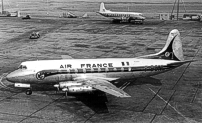
Air France Viscount c/n 10 F-BGNL.
Twenty-Four Viscount airliners - the first batch of Britain's world-beating prop-jet off the production line -
were taken out of service yesterday after the dramatic discovery by a mechanic of cracks round vital bolts in
the main wing spar. The grounded airliners belong to British European Airways, Air France, and Aer Lingus. But
the main fleet of 260 Viscounts - all later models - now flying on the world's airlines, is not affected.
New wing spars will take about four to six weeks to fit in maintenance hangars of the airlines at London, Paris,
and Dublin airports. While this work goes on the services normally flown by these Viscounts will be taken over
by other planes - some of them by Viscounts of later design.
Air Board's decision
A spokesman of Vickers Aircraft Ltd. - makers of the Viscount - said last night: "The grounding of these
Viscounts followed a meeting between our chiefs and the Air Registration Board today." The Board, which has the
final word on the air-worthiness of any plane, examined a wing spar sent back to the makers by Air France.
They found cracks round bolt holes which had been marked by a mechanic during a routine inspection. They were
cracks which they would never have expected to see until the aircraft had been flying much longer than the four
years it has so far been in service.
NEW PAGES TO THE WEBSITE SINCE THE LAST NEWSLETTER
Vickers Viscount Network UK researcher Julian Bourn who is researching the BEA - British European
Airways Viscount fleet, has completed several more aircraft. Unfortunately due to other commitments the web
production team have not been able to process this material but hope to be able to put it onto the site in the
near future.
However a new report on the restoration of Viscount c/n 283 ZK-BRF and a new 'mystery' have been completed (see
above items).
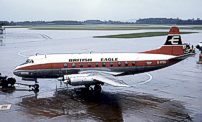
British Eagle Viscount
c/n 87 G-ATDU.
Also there have been new photos added to the following aircraft:-
c/n 87, c/n 152, c/n 168, c/n 213, c/n 243, c/n 257, c/n 280, c/n 375, c/n 386, c/n 436, c/n 457.
To see the photo gallery of an aircraft, on the site go to [Photos] [Viscount Photo Gallery]. Select the
Construction Number or Registration that you are interested in, e.g. 87 or G-ATDU, then press [Go]. Note;
keep an eye on the right hand side red column of every page on the website for a list of the latest 20
aircraft that have had photos added.
LIGHT HEARTED BUT TRUE VISCOUNT MOMENTS:
What is it about Viscounts and fog! By sheer coincidence we have received two stories from Viscount Captains,
one in England and one in New Zealand, on the subject. Read on!
Retired NAC - New Zealand National Airways Corporation Captain Bill Rainbow reports:
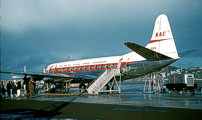
New Zealand National Airways
Corporation Viscount
c/n 281 ZK-BRD.
I was flying Viscount c/n 281 ZK-BRD, City of Wellington from Christchurch to Dunedin on 25 June 1968. This
particular day, when we departed Christchurch; Dunedin Airport was closed with fog. The forecast was not
expected to clear for several hours. As fog clearances are very difficult to predict we decided to depart and
we had on board sufficient fuel for several let-downs then enough to return to Christchurch if necessary.
Dunedin Airport is in a valley and our approach was from the north. If I recall correctly our minimum descent
altitude with the aids available was 200ft. We made two approaches to minimum altitude and never sighted the
airfield so I made an announcement to the pax's that we would orbit over the airfield for a while and if the
fog did not disperse we would return to Christchurch.
Shortly after that the cockpit door opened and a hostess appeared and said, "I do hope we can land as my
boyfriend has driven all the way up from the far south to see me and he will be so disappointed! (if we don't)"
Being a romantic at heart I said, "I will make one more attempt to land and if we are not successful we will
have to return to Christchurch."
We made our approach and came down to minimum altitude and once more we made no contact with the airfield. I
was just about to apply go-around power and overshoot when a small hole in the fog appeared and I could see
the 1,000ft markers. I thought, I can make that, so I proceeded to land.
The touch down was smooth, and as we entered the fog once more, I applied full braking but the only problem
was we had skipped back a few feet into the air with full braking applied and the anti-skid active. Of course
when we touched down once more all the tyres blew out and we came to a rather abrupt halt on the runway with
the aircraft enveloped with smoke. I contacted the tower and informed them of our ignominious landing which of
course they had not seen because of the fog. Their reply was that the crash wagons were on the way but all they
had to do was to find us first!
So there we were in the cockpit feeling rather silly and sorry for ourselves when the cockpit door flew open
and in came the same hostess and she said to me, "Gee Captain I hope you didn't do all of this just for my
benefit!" I heard later that when she finally got to the terminal, her boyfriend proposed marriage!
The tyre marks remained on that runway for years and it was always called "Rainbow's Folly".
Just days after Bill Rainbow's story arrived Willy Weber sent in these two. He sarcastically describes them as
boring.
Boring anecdote # 1:
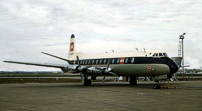
BEA - British European Airways
Viscount c/n 151 G-AOJB.
T'was in the autumn of '65. Domestic scheduled service Berlin / Bremen early one foggy Sunday morning (about 45
minutes, via the infamous 'Central Corridor'). The ship was V.802 c/n 151 G-AOJB (Dart 510s) fitted with the
standard 'German Internal' 66 seat layout, and known affectionately as 'Jingle Bells'. The Captain was Brian
Edmonds - a quiet, pipe-smoking gentleman of the old school and a pleasure to fly with. I was his pee two and
had only recently joined the Company. My turn to drive.
Being early on a Sunday morning we only had about 5 punters, so lots of spare 'petrol'. The German fog
persisted and we groped our way round and round trying to find Bremen. It took several 'stabs' but we found it
eventually as the fog was dispersed by the rising sun. The landing was on runway 09, i.e. straight into the
aforementioned big round thing. The inevitable happened - non precision approach - visual at the last moment -
not quite lined up - 'fishtail' sort of landing with a little drift on.
Bang Bang - two burst tyres on the left main gear. Oh dear (stronger words actually!)
Single runway airfield - firmly blocked. KLM, Lufthansa and Pan Am all had to divert. We were like the
proverbial pork pie in the synagogue and soon surrounded by vehicles of all shapes and sizes.
Brian, the five punters and two German stewardesses were 'escorted' into the terminal by the airport manager,
leaving me and the only engineer on duty (Lufthansa - we had no cover of our own for some reason) to struggle
with a hydraulic jack and 'borrowed' pair of wheels. It took us ages (the jack kept sinking into the tarmac).
Just as we finished and were hooking up the 'borrowed' tug to tow 'Jingle Bells' off the runway, Brian, the
stewardesses and the Lufthansa station manager drove up in a huge fire engine. They were carrying a big silver
tray with biscuits, a bone china pot of hot chocolate and some dainty little cups and saucers.
I remember thinking 'what a civilised outfit I have joined!'.
Boring anecdote # 2:
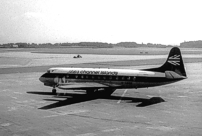
BEA - British European Airways
Viscount c/n 253 G-AOHW.
T'was in the autumn of '69 (here we go again). Scheduled service Jersey / Southampton (not foggy this time).
The ship was V.802 c/n 253 G-AOHW (Dart 510s) fitted out with 71 seats and just off a major of some sort.
Captain Ken Rabey - also a pleasure to fly with. His turn to drive.
Only 17 punters, so plenty of 'petrol' thank goodness. All going fine until passing the Fawley oil terminal.
'Gear down please' - only two green lights came on. Oh dear (expletives deleted). Try the spare set of bulbs -
same result. Check the mechanical indicators - same result. The right main gear was not locked down.
We stooged around the Southampton area raising and lowering while arguing with 'Maintrol' at Heathrow. They
were of little help with few suggestions to make other than to wish us luck.
21 souls on board; endurance - about 3 hours. What do we do, where do we go now?
Southampton runway is a bit short and the management had made it quite clear that we were not welcome. Ok -
sod you then we'll go to Gatwick. We made it as far as Midhurst before being told that Gatwick will accept us
under NO circumstances. Ok - sod you too we'll try Stansted. We were in the stack at Brookman's Park when the
message came through loud and clear 'the airport director says you can't crash here'.
Sod the lot of you. Manston were on 'reduced fire cover', so we were negotiating to go to Prestwick (Scotland)
when someone must have thrown a hissy fit at our Ops centre and demanded action from the Home Office. Heathrow
reluctantly agreed to accept us on condition we used their short runway 23 (now closed) but please try not to
crash at the intersections with 28R or 28L. Oh dear.
After stooging around for another couple of hours burning off as much 'petrol' as prudent (no dumping facility
on UK registered V.800s) we made an approach to runway 23 at Heathrow under full emergency status.
Ken 'greased' her on, left wing low. A knowledgeable punter sitting with a view of the right wing said he saw
the mechanical indicator pop up as we touched.
Phew. Who says scheduled services are mundane?
Willy Weber
HIJACK ATTEMPT - TORONTO TO CUBA WITH AIR CANADA.
Following an attempted hijack to Cuba of a Toronto-bound Viscount the following appeared in the Airline's
October 1968 newsletter "Between Ourselves" and has been sent in by Terry Baker. Note; Vickers Viscount
co-founder and Historian Brian Burrage has asked if anyone can help us identify this Viscount.
HERE'S ONE ANSWER TO ALL HIJACKERS!
One tongue-in-cheek offer came from commercial pilot W. J. McFee:
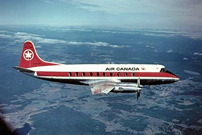
Air Canada Viscount
c/n 301 CF-THJ.
To avoid aging the Captain and co-pilot prematurely the following suggestion "How to out Fox the 'plane
Hijacker' is offered at no cost to Air Canada."
Requirements or props: A convenient airport located somewhere in the southern part of the USA. Potted Palms
which could be moved in and around the airport to give the Cuban appearance. Bearded soldiers, all armed to
meet the commandeered aircraft. Cuban spelling on Hangar and everything possible to give a Cuban appearance.
Once the commandeered aircraft radiophones (in code) that he has on board a demented passenger with a large
sized gun who demands that he be flown to Cuba, the action at the Cubanized airport begins. Once the aircraft
is landed and the passenger walks out (thinking he's now in the land of sugar cane and cheap rum) he is slugged
with lead pipe. The slugging should be done by someone who has had experience in Chicago's recent riots.
Of course all this must be kept in absolute secrecy to be effective for once out and any publicity given,
Hijackers would be wary. "As stated earlier there is no cost to Air Canada for this suggestion. Although a
round trip to Europe would be appreciated."
IF YOU have a light hearted BUT TRUE Viscount moment to share, or any other information for the
newsletter, please send it direct to both the Newsletter Editors for consideration at
membership@vickersviscount.net.
INTERNET EXPLORER 6
We have been advised that pages on our website load with a lot of blank space while using Internet Explorer
6. Vickers Viscount Network co-founder and webmaster Geoff Blampied says that this is caused by this
old browser not being able to handle the latest web technology used in the creation of our website. This issue
is easily fixed with an upgrade to Internet Explorer 7 that is available FREE from Microsoft. There are
three further FREE web browsers, 'Firefox', 'Opera' and 'Flock', that also correctly handle our website.
Apple Mac users and users of the new Google browser 'Chrome' are unable to use our websites menu. Apple Mac
users are able to download a FREE version of 'Firefox' that cures this issue.
Well that's it for the September issue and we hope that you've enjoyed it.
Best regards
Peter Layne, Wellington, New Zealand, Ed Jones, Manchester, England and all the team at the
Vickers Viscount Network.
If you missed our first regular Newsletter, (July 2008), you can read it and all subsequent editions on our
website. Just go to [News] [Vickers Viscount Network Newsletters].
To provide information and photos for inclusion in the Virtual Museum please send them to
information@vickersviscount.net
Photos should be scanned as jpg's at 300 dpi or over. If you need help scanning your photos then contact
Brian Burrage at
brian.burrage@vickersviscount.net
who provides the Vickers Viscount Network quality, secure and FREE scanning service.
To add a friend or colleague to the Vickers Viscount Network membership, on the site go to [Home] [Join the
Vickers Viscount Network for free] [Click here to join the Vickers Viscount Network].
To cancel your membership to the Vickers Viscount Network send an e-mail to
membership@vickersviscount.net.
The Vickers Viscount Network team are all unpaid volunteers who work on this project around their
daytime jobs and family commitments.
Any opinions expressed in this publication are not necessarily those of the Vickers Viscount Network or
the Newsletter Editors.



